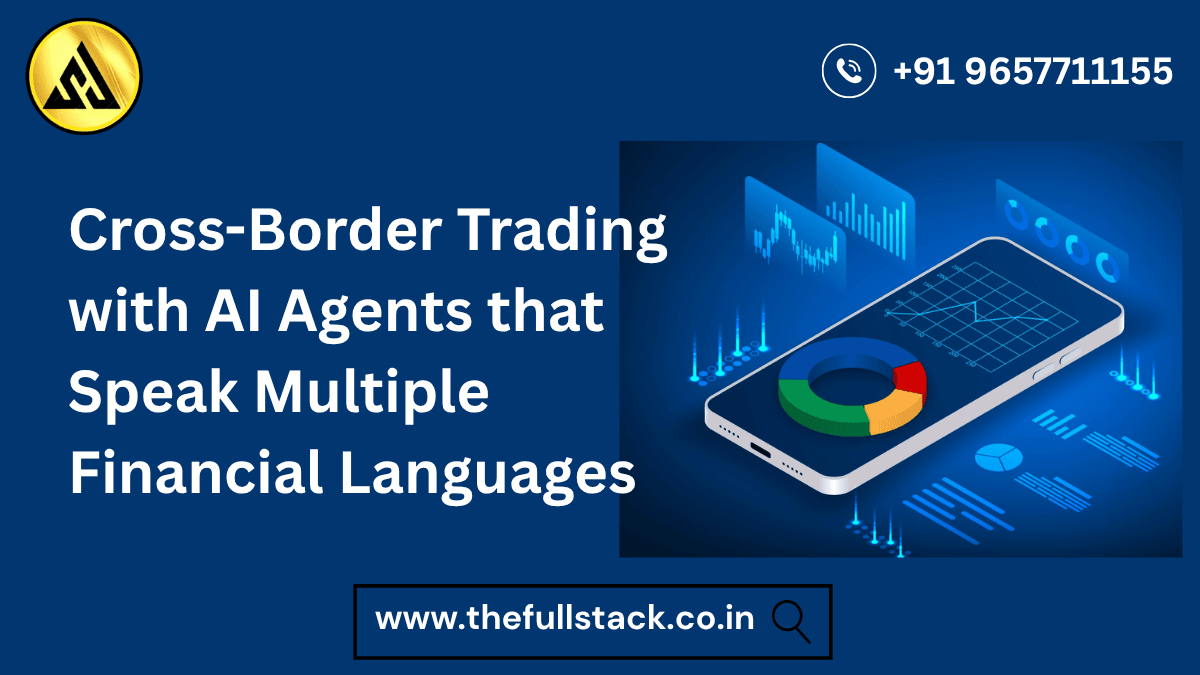
Cross-Border Trading with AI Agents that Speak Multiple Financial Languages
Global financial markets are more interconnected than ever. Traders today aren’t limited to their local exchanges—they can participate in stock markets, forex, and commodities across continents. But with this opportunity comes a challenge: different financial rules, regulations, and languages.
This is where AI agents capable of understanding multiple financial languages step in. These intelligent systems can analyze data from different countries, interpret diverse financial jargon, and execute trades efficiently—all while helping traders navigate complex international markets.
In this blog, we’ll explore the fundamentals of cross-border trading with multilingual AI agents, why it matters for beginners and professionals, key market trends, practical tips, and real-world applications.
What Are AI Agents in Cross-Border Trading?
AI agents are software programs that perform tasks autonomously using machine learning, natural language processing (NLP), and predictive analytics. In the context of cross-border trading, these agents can:
- Read and interpret financial news in multiple languages.
- Analyze market trends across different countries.
- Execute trades according to local market rules.
- Provide insights and recommendations to traders in real time.
Imagine having an assistant that not only understands New York Stock Exchange rules but can also interpret reports from the Tokyo Stock Exchange or London’s FTSE—all in your preferred language. That’s the power of multilingual AI agents.
Why Multilingual AI Agents Matter
1. Breaking Language Barriers
Global markets speak many languages. Reports, filings, and news updates might come in English, Japanese, German, or Mandarin. A multilingual AI agent translates, interprets, and summarizes these, giving you actionable insights.
2. Faster Decision-Making
Cross-border trading requires speed. AI agents process massive datasets in real time, helping traders make decisions before opportunities vanish.
3. Reducing Errors
Manual interpretation of foreign reports can lead to mistakes. AI agents ensure accuracy and consistency in translation and analysis.
4. Compliance Across Borders
Financial regulations vary by country. AI agents can be programmed to follow local rules, reducing the risk of regulatory violations during trades.
Market Trends in Cross-Border AI Trading
The adoption of AI for global trading is accelerating due to several factors:
- Rise of Global Retail Investors – More beginners and small investors are participating in international markets.
- AI-Driven Multilingual Tools – Platforms now integrate natural language processing for multiple financial languages.
- Regulatory Complexity – Automated compliance ensures trades follow local laws.
- Data Explosion – AI helps process international data streams from news, social media, and financial statements.
According to industry reports, AI adoption in cross-border trading is expected to grow by 40% over the next five years, highlighting its increasing relevance.
Real-World Applications
- Forex Trading – AI agents interpret global macroeconomic news in multiple languages to predict currency movements.
- Equity Markets – Agents analyze international corporate reports, earnings calls, and financial news to guide investment decisions.
- Commodity Trading – From oil to gold, AI agents can interpret global supply-demand signals in real time.
- Cross-Border Risk Management – AI identifies country-specific risks such as political instability, currency fluctuations, or policy changes.
Example: A trader wants to invest in emerging tech stocks in China. The AI agent reads reports in Mandarin, interprets Chinese regulatory updates, analyzes market trends, and provides actionable recommendations—all in English.
Practical Tips for Beginners
- Start with One Market – Begin by using AI agents for a single foreign market to understand how they function.
- Learn Local Basics – Familiarize yourself with basic trading rules, currency conversions, and local regulations.
- Monitor AI Decisions – Don’t blindly follow AI. Track performance and understand the rationale behind recommendations.
- Use Multilingual Reports – Let AI summarize international reports rather than translating word-for-word for accuracy.
- Stay Updated – Global markets change rapidly. Ensure your AI tools receive real-time updates.
Relatable Example for Beginners
Think of cross-border trading like traveling abroad for business. You need local knowledge—currency, culture, rules—but you can’t be an expert in every country. A multilingual AI agent is like having a local guide who reads news, understands regulations, and helps you navigate the market efficiently.
For beginners, this approach reduces errors, builds confidence, and accelerates learning.
The Future of AI in Cross-Border Trading
- Integration with Explainable AI (XAI): Agents will provide reasoning for each trade recommendation.
- AI-Powered Market Insights: Real-time trend analysis across multiple countries.
- Advanced Risk Management: Predicting geopolitical, economic, and regulatory risks before they impact portfolios.
- Global Collaboration: Traders and institutions sharing AI-driven insights while respecting local privacy laws.
By combining AI’s computational power with human judgment, cross-border trading becomes safer, faster, and more profitable.
Conclusion
Cross-border trading with AI agents that speak multiple financial languages is no longer a futuristic concept—it’s happening today. For beginners and company employees alike, these intelligent agents simplify global markets, reduce errors, and enhance decision-making.
With AI as your multilingual assistant, you can confidently navigate international investments while staying compliant and informed.

What is AWS Lambda?A Beginner’s Guide to Serverless Computing in 2025
Java vs. Kotlin: Which One Should You Learn for Backend Development?


Leave a Reply